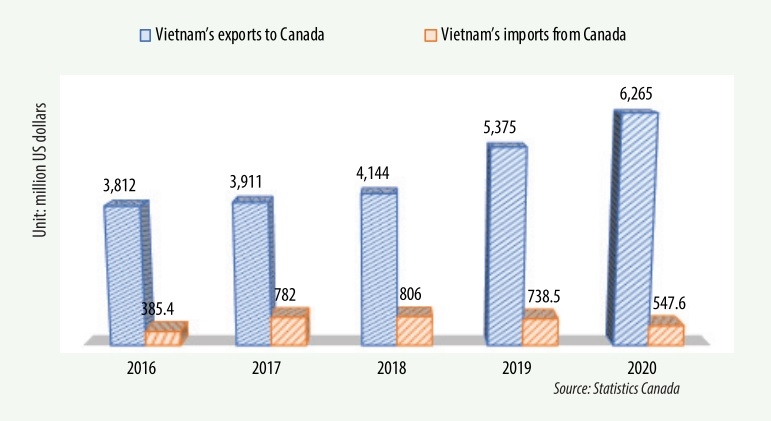Lively increase in trade with Canada
 |
| Lively increase in trade with Canada |
Despite the devastation caused to the global economy and international trade during the last year, the Comprehensive and Progressive Agreement for Trans-Pacific Partnership (CPTPP), which was put into effect in January 2019, has significantly improved the export and import values between the two countries.
Vang Vien Thong, director of textile and garment group Nam Anh Co., Ltd., said that 2020 was not all bad for the company thanks to the incentive tariffs of import and export between Vietnam and other CPTPP member countries.
“Textile and garments of Nam Anh exported to the Canadian market last year increased by around 10 per cent on-year despite the pandemic and the disruption to trade activities,” said Thong.
As a whole, last year was considered a successful one for Vietnam in its bilateral relationship with Canada, with two-way trade turnover at $8.9 billion, increasing by 12 per cent on-year. Of this, the export value of Vietnam to Canada hit $6.3 billion, rising by 12.8 per cent on-year, including $2.2 billion of electrical and electronic equipment (increasing by 49 per cent on-year), and processing seafood, tea, coffee, wood and furniture, plastic and rubber, and metals.
However, some other sectors reported negative growth like textiles and garments (-6.7 per cent), handbags (-28 per cent), and footwear (-15 per cent) due to the pandemic.
According to Bui Tuan Hoan from the Ministry of Industry and Trade’s European-American Market Department, the sectors are still a promising land for Vietnam’s goods to enter Canada thanks to removal of tariffs.
For example, the tariffs to footwear, bags, metal items, plastic and rubber, souvenir agricultural products, and seafood have been removed immediately, while textiles and garments will be cut within three years from 17-18 per cent to zero, and furniture will be exempted within seven years from 9.5 per cent to zero.
“The CPTPP has improved access for trade between Canada and Vietnam, reinforced a common set of rules, lowered the cost of trade, and made investments more predictable. This helps improve the competitive advantages of products in our respective markets,” said Deborah Paul, Ambassador of Canada to Vietnam.
Vietnam has also been Canada’s largest trading partner in the ASEAN region since 2015, and the second-largest destination for the country’s agri-food and seafood exports within ASEAN in 2020. Top Canadian agriculture and agri-food exports to Vietnam include grains, oilseeds, fish and crustaceans, fruit, beef and pork, and dairy products.
The CPTPP is the first free trade agreement between the two countries, as well as the first deal between Vietnam and a North American country, while being the second agreement for Canada in Asia after the deal struck with South Korea.
“Currently, the CPTPP is the only path for both countries to take in order to access the entire market of the other partner,” said Vu Tien Loc, chairman of the Vietnam Chamber of Commerce and Industry.
The growth of the two-way trade value in 2020 was less than that in 2019 (30 per cent), but still doubled the average growth of export-import turnover of Vietnam. Utilising tariff incentives of the deal for Vietnamese items exporting to Canada has performed better than other country members. “Vietnam-Canada trade relations are one of the most successful tie-ups that the CPTPP has mustered,” said Loc.
Additionally, it provides improved market access in areas such as financial services, ICT, and infrastructure, and allows Canadian and Vietnamese companies to invest in the others’ country with greater confidence.
What the stars mean:
★ Poor ★ ★ Promising ★★★ Good ★★★★ Very good ★★★★★ Exceptional
Related Contents
Latest News
More News
- Global partnerships key to Vietnam’s IFC development (December 26, 2025 | 16:18)
- Vingroup pulls out of bid to invest in North-South high-speed railway (December 26, 2025 | 11:42)
- Strengthening supply chains through trade promotions and customs reform (December 24, 2025 | 14:00)
- PM orders investment model for North–South high-speed rail (December 22, 2025 | 17:43)
- LS Eco Energy to invest in Vietnam rare earth sector (December 22, 2025 | 17:31)
- Government moves to establish International Financial Centre (December 21, 2025 | 21:00)
- Vietnam's IFC to target global investment flows (December 21, 2025 | 18:00)
- Two national hospitals expand capacity with new facilities (December 20, 2025 | 09:00)
- Ha Tinh breaks ground on major Vingroup industrial and energy projects (December 19, 2025 | 18:24)
- EVN launches major power infrastructure projects nationwide (December 19, 2025 | 18:17)

 Tag:
Tag:





















 Mobile Version
Mobile Version